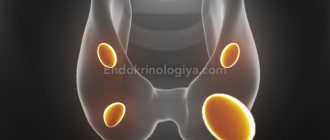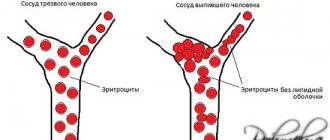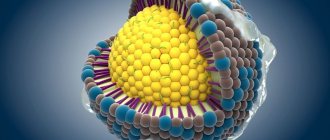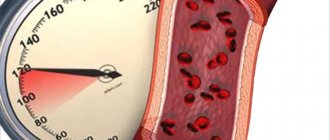Most people believe that cholesterol is a dangerous substance for the body. Indeed, its excess has a negative impact on health, but its deficiency does not lead to anything good. Every person needs to have their cholesterol levels tested annually to detect deviations from normal levels. Below we will talk about how to correctly donate blood for cholesterol and decipher the test result.
Cholesterol is an essential substance for the body
It is fundamentally false to say that cholesterol only has harmful effects. This fat-like substance (“fat bile” in literal translation) envelops all cell membranes of the body, protecting them from adverse factors.
Without cholesterol, the brain cannot function - it makes up a significant part of the white and gray matter. The sheath of nerve fibers also contains cholesterol. Due to its participation in the production of hormones, it is necessary for the full functioning of the adrenal glands and reproductive system.
Cholesterol is partially synthesized by the body, the rest comes from food.
How to donate blood correctly
Serum cholesterol testing is a fairly common test. Any laboratory can do it, but for this it is advisable to pre-register for the study. The result will be ready in a few hours or the next day. How to donate blood for cholesterol and how often should it be done?
Preparation for the procedure
Modern medicine makes it possible to perform any study with maximum accuracy and reliability of the results obtained. However, there are factors that can affect the lipid profile and distort the result: food, alcohol, smoking, taking medications, severe stress.
Before taking the test, you need some preparation, and you must follow each rule for donating blood for research, described below:
- blood is donated on an empty stomach. You must eat no later than 12 hours before the test;
- within a few days, all fried and fatty foods are excluded from the diet;
- Also, for 3 days you cannot drink alcohol, smoke, or take dietary supplements;
- You should definitely notify your doctor about taking antibiotics, vitamins, hormones, diuretics and antihypertensive drugs, non-steroidal anti-inflammatory drugs, contraceptives, as they can greatly distort the test result;
- You need to notify your doctor about the presence of chronic diseases.
Carrying out analysis
To perform a blood lipid profile, material is taken from a vein. The procedure itself takes a few minutes. However, some patients experience some discomfort when donating blood. These sensations in most cases are associated with a psychological mood. To avoid unpleasant sensations and worries, it is advisable to come to the laboratory a little earlier. This will help you avoid tedious waiting in line. Immediately after the analysis, it is advisable to go outside and breathe fresh air, this will help improve your well-being.
The form with the results of the analysis will indicate the level of total cholesterol, HDL, LDL, as well as the norm for each indicator. It is not advisable to draw conclusions on your own, much less make a diagnosis for yourself, since the conclusions and interpretation of the data obtained may be erroneous and bring unnecessary emotional distress to the patient. Incorrect results may be the result of improper procedure technique.
Reader Recommendation:
To clean VESSELS, prevent blood clots and get rid of CHOLESTEROL, our readers use a new natural drug recommended by Elena Malysheva. The preparation contains blueberry juice, clover flowers, native garlic concentrate, rock oil, and wild garlic juice.
Also, with a lipid profile, the norm is determined conditionally and may differ for each individual person.
Possible reasons for deviations from the norm in the results
As already mentioned, only a doctor should interpret the analysis, correlate the results obtained with the norm, and establish a diagnosis and treatment tactics. However, it is necessary to have some understanding of the reasons for the increase or decrease in the amount of cholesterol.
A high rate can be caused by the following factors:
- food with excessive amounts of animal fats;
- excess weight;
- hereditary factor;
- pregnancy;
- sedentary lifestyle;
- old age.
- unbalanced diet;
- stress
Possible pathological processes:
- IHD;
- ailments of the liver, kidneys;
- hypothyroidism;
- inflammatory processes and tumors of the pancreas;
- pathology of the pituitary gland;
- obesity;
- early menopause;
- drinking alcohol, smoking
Insufficient lipid levels may have the following reasons:
Our readers recommend!
Many of our readers actively use the well-known method based on Amaranth seeds and juice, discovered by Elena Malysheva, to CLEAN VESSELS and reduce the level of CHOLESTEROL in the body. We recommend that you familiarize yourself with this technique.
- strict diets;
- malignant neoplasms;
- liver diseases;
- diseases of the central nervous system;
- anemia;
- burns, sepsis.
To summarize, we can say that correct analysis is a rather complex procedure: it is necessary to take into account a lot of factors that can affect the results of the study and, accordingly, cause incorrect therapy. Therefore, before donating blood for cholesterol, it is better to further study the intricacies of the procedure so that the results are as reliable as possible.
Do you still think that it is completely impossible to RESTORE blood vessels and the BODY!?
"Good" and "bad" cholesterol
Doctors divide cholesterol into good and bad due to the heterogeneity of its composition:
- “good” has a high density, it does not settle on the walls of blood vessels, i.e., it does not provoke the appearance of cholesterol plaques;
- “bad” has a low density and can lead to the formation of plaques, as a result of which the walls of blood vessels are injured and their lumen is significantly reduced.
How is it that cholesterol is both good and bad? It is transported from the blood to organ tissues using special proteins - lipoproteins. These proteins also have different densities, which determines the quality of cholesterol transfer. Low-density proteins are not able to completely transfer it - part of the cholesterol remains in the blood vessels.
Decoding the analysis results
Bad and good cholesterol are designated differently:
- HDL (alpha cholesterol). The high-density type of cholesterol is beneficial because it is not deposited on the vascular walls, but goes directly to the liver, performing important functions for the body. The norm for HDL is 1 mmol per liter or more.
- LDL (beta cholesterol). A low-density type of substance is harmful to the body. This type of cholesterol sticks to the walls of blood vessels, forming atherosclerotic plaques. The norm for LDL is 3 mmol per liter.
Based on the results of the analysis, the atherogenic index is determined (the ratio between high-density and low-density cholesterol). To decipher the lipid balance, use the abbreviation KA. If the coefficient is less than 3, the subject is healthy. Atherosclerosis is indicated by an index exceeding 5 KA. This indicator indicates a high risk of developing coronary heart disease.
If cholesterol is elevated, we can talk not only about coronary heart disease, but also about diabetes, kidney disease, pancreatic cancer, alcoholism and obesity. At the same time, too low an indicator of the tested substance indicates health problems. Lack of cholesterol is observed in advanced liver cirrhosis, chronic anemia, bone marrow pathologies, and in the presence of neoplasms.
Cholesterol appears as “total cholesterol” in biochemistry results. In some cases, the abbreviation HS is used. However, the result is often indicated in English or Latin. This is not done in order to confuse the patient, but because in this case the form is filled out by the device itself. The laboratory assistant only needs to enter the analysis results on the form.
The following designations are used in foreign languages:
- Chol (cholesterol) - total cholesterol;
- HDL (high density lipoprotein) high-density lipoprotein;
- LDL (low density lipoprotein) low density lipoprotein.
Note! If the general analysis does not provide an accurate picture, the doctor prescribes other studies, including a detailed analysis.
to the point ↑
Norms for women
Below is a table in which the norms for women are indicated in accordance with their age. This table will help you correctly decipher the lipid balance.
In women, cholesterol levels remain at approximately the same level throughout life. However, their cholesterol levels can vary significantly depending on certain events or conditions, including:
- season;
- pregnancy;
- day of the menstrual cycle;
- chronic diseases;
- neoplasms.
to the point ↑
Norms for men
Men experience a gradual increase in cholesterol levels throughout their lives. In an adult healthy man, the total cholesterol level ranges from 2.52-3.6 mmol per liter. By segment, the indicators are as follows: HDL - from 0.7 to 1.8 mmol per liter, LDL - from 2.25 to 4.83 mmol per liter.
Lipoprotein standards for men are shown in the table below.
to the point ↑
Who needs to monitor their cholesterol levels?
Cholesterol should always remain normal. Its deficiency affects the mental state, and its excess provokes the occurrence of serious diseases or complicates the course of existing ones.
Taking a blood test for cholesterol is an important point in monitoring your health. It is recommended to get tested annually to prevent the development of serious illnesses in a timely manner.
People at risk for high levels of bad cholesterol:
- smokers;
- obese people who are prone to gaining excess weight;
- hypertensive patients;
- having diseases of the heart, blood vessels, liver, kidneys, thyroid gland;
- with a sedentary and sedentary lifestyle;
- having diabetes mellitus;
- women during menopause;
- elderly people.
How often to take a cholesterol test for people belonging to any category should be decided by the attending physician on a case-by-case basis after a thorough examination.
Where to take the study?
You can take a cholesterol test:
- in the laboratory of the clinic if there is a referral from a therapist;
- in a private diagnostic center;
- in an independent laboratory;
- take advantage of .
Cholesterol is an important substance that is involved in the functioning of the body. Each person needs to maintain an optimal value and periodically monitor LDL levels. Traditional recipes, proper nutrition, and medications will help bring the indicators back to normal.
source
Preparing for the test
The result of the test depends on knowing how to properly donate blood for cholesterol. This is actually very important. To get an accurate picture, special attention should be paid to preparing for a blood test for cholesterol:
- During the week preceding the study, do not consume fatty or fried foods or alcohol. Strictly prohibited for consumption: products containing animal fats, cheese, sausage, egg yolk.
- In at least 2-3 days, eliminate the possibility of stress: overload at work, nervous breakdowns. It is also recommended to postpone visits to attractions and hardening procedures; going to the bathhouse and sauna is not advisable.
Blood sampling is carried out on an empty stomach; the last meal session should take place 12 hours before the test.
Analysis and nutrition rules
The diet before donating blood for the concentration of total cholesterol, high and low molecular density lipoproteins is an important condition for the preparatory period.
3 days before taking cholesterol tests, you must completely exclude from your diet the following types of foods, the presence of which can distort the test results:
- fried potatoes, eggs, bacon, lard and lard;
- meat that does not belong to the category of lean varieties (lamb, pork, nutria, duck);
- all types of sausages, smoked meats, canned meat and fish;
- butter, milk with a fat content over 2%, fermented baked milk;
- mayonnaise, ketchup, sauces containing trans fats, palm oil, preservatives and other chemical additives;
- dishes that were prepared with the addition of a large amount of hot spices, as well as using marinade.
You should not eat confectionery products, since most baked goods, sweets, cakes, and pastries contain fats of animal and vegetable origin. Their concentration is so high that eating these products will undoubtedly affect the results of the analysis. The menu should contain products that provide the body with a sufficient amount of food energy, proteins, fats and carbohydrates. At the same time, they do not burden the liver, the organs of the gastrointestinal tract, and also do not increase cholesterol.
For 3 days before donating blood for lipoprotein levels, it is recommended to eat the following foods:
- cereal porridges made from wheat, oatmeal, barley, buckwheat, pearl barley, rice or corn;
- vegetables baked in the oven, stewed in their own juice with the addition of a small amount of vegetable oil, or grilled;
- mashed potatoes, to which a small amount of milk with a minimum percentage of fat content is added;
- skinless chicken breast, steamed or boiled in water in the standard way;
- vegetable and fruit salads seasoned with sunflower, flaxseed or olive oil;
- puree soups based on peas, lentils, soy or beans with the addition of croutons;
- regular drinking water without gases.
Before preparing to donate blood, you need to purchase in advance a sufficient amount of products that will allow you to organize proper nutrition for 3 days. Everything that cannot be eaten during the preparatory period must be excluded from the diet.
On the day of donating blood for analysis
Before donating blood for a cholesterol test, you need to abstain from smoking for at least 4 hours. At the same time, the consumption of carbonated drinks, juices, fruit drinks, tea, coffee, etc. is prohibited. You are allowed to drink clean water without gas.
In order for the result to be as reliable as possible, it is not enough to just follow the recommendations on how to properly donate blood for cholesterol and prepare for the test. The emotional state is of no small importance. Before the procedure, you need to get enough sleep, and half an hour before donating blood, relax and think about pleasant things.
Blood is taken from a vein, so you need to take care of comfortable clothing in advance.
Cholesterol-lowering foods
There are quite a few products that lower cholesterol, but the main product that effectively reduces it is, oddly enough, fatty fish. It is fish that contains the so-called good cholesterol and polyunsaturated fatty acids. They bind bad cholesterol and remove it from the body.
Lean beef will also help reduce cholesterol levels. All vegetables and fruits are also beneficial. You can very well lower it by eating grapefruits and apples. Tea is very beneficial, especially green tea because of the tannins it contains.
The following foods are useful for lowering cholesterol levels: any vegetable oils, chicken, turkey, natural juices from fruits or vegetables, beef, more fruits, almonds, tree nuts, peanuts.
Eat more vegetables in any form, preferably lightly cooked ones. Low-fat milk, low-fat cottage cheese, yoghurt and kefir are healthy. Diet for cerebral atherosclerosis
Lemongrass oil. A common flavoring in Eastern foods, lemongrass oil lowered cholesterol by more than 10% in one study. It works by interfering with the enzyme reaction and delaying the formation of cholesterol from simple fats.
Tea. Or more accurately, the tannin found in it can help control lipid levels. One study found that people who habitually drink tea on a high-cholesterol diet had blood tests with cholesterol levels of 5.2 mmol/L.
Spirulina, a protein-rich type of seaweed often sold in powder or tablet form, has been shown to lower both total cholesterol and LDL. The observation was carried out on Japanese volunteers with high lipid levels who took 7 tablets of 200 mg after each meal.
Rice bran. This fiber may be just as effective as its cousin oats. Preliminary studies in hamsters have shown that rice bran reduces lipoproteins by more than 25%.
Barley. Long considered a healthy, fiber-rich grain, barley has the same cholesterol-lowering potential as oats. In animal studies, 2 chemical components of barley reduced cholesterol by 40%.
Activated carbon. When crushed well, this substance, which is usually taken to relieve gas, can attach to cholesterol molecules and safely remove them from the body. In one study, patients showed a 41% reduction in LDL levels after taking 8 g of activated charcoal three times daily for 4 weeks.
Niacin. “Large doses of niacin (also known as niacin) can lower both total cholesterol and ADL-cholesterol,” says renowned researcher Dr. Kenneth Cooper of Dallas, Texas.
- It is best to start with small doses, say up to 100 mg per day. Then gradually increase the dose over several weeks to 1-2 g 3 times a day, for a total of 3-6 g per day." “But remember that suddenly increasing your niacin intake can cause severe skin redness, intestinal upset, and sometimes liver damage,” warns Dr. Cooper.
Be sure to discuss this treatment with your doctor. Nicotinamide is a form of niacin that does not cause redness and does not have a significant effect on fats.
Vitamin E: One study by French and Israeli scientists found that 500 international units of vitamin E per day for 90 days significantly increased HDL. “Our results support the use of vitamin E in individuals with high levels of body fat,” the researchers said.
Vitamin C: Tufts University researcher Paul Jacques found that vitamin C raised levels of protective HDL cholesterol in older adults he studied.
He estimates that 1g per day can increase HDL by 8%. Other studies have shown that when extra vitamin C is added to a pectin-rich diet, cholesterol drops even lower than from pectin alone.
Conveniently, many pectin-rich fruits and vegetables, such as citrus fruits, tomatoes, potatoes, strawberries and spinach, are also rich in vitamin C.
Calcium. You take calcium supplements to strengthen your bones, but they can also help your heart. One study found that 1 g of calcium per day for 8 weeks reduced cholesterol by 4.8% in those with moderately high levels. Another study found that 2 grams of calcium carbonate per day reduced cholesterol by 25% over 12 months.
Normal blood cholesterol levels
The unit of measurement for blood cholesterol is mmol/L. It is one of the 3 main units of laboratory research and shows the atomic (molecular) mass of cholesterol per 1 liter of blood.
The minimum amount of cholesterol in the blood is 2.9 units, it is detected in children at birth, and increases as they grow older.
The amount of cholesterol differs between men and women. In addition, in women the indicator grows slowly, while in men it increases sharply in adolescence and middle age. With the onset of menopause in women, the amount of cholesterol increases rapidly and becomes much higher than in men of the same age. That is why the onset of menopause is a good reason to donate blood for research.
The normal range of blood cholesterol levels in women is considered to be 3.5-7 units, in men – 3.3-7.8 units.
If the study shows deviations from the norm, you need to donate blood for an extended analysis of the amount of lipoproteins, showing the ratio of “good” and “bad” cholesterol.
The norm for low-density proteins: for men – 2.3-4.7 units, for women – 1.9-4.4 units; high: for men – 0.74-1.8 units, for women – 0.8-2.3 units.
Additionally, the amount of triglycerides, substances involved in cholesterol metabolism, is detected; the unit of measurement is also mmol/l. Their number should not exceed 0.6-3.6 units. in men and 0.5-2.5 units. among women.
The final step is to calculate the atherogenicity coefficient: the ratio of “good” to “bad” is subtracted from the amount of total cholesterol. If the result obtained is no more than 4, it is considered that the state of cholesterol metabolism is normal.
Important! The indicators may have slight deviations, which may be the norm - they are individual for each person.
Assessment of lipoprotein parameters
In a medical institution, namely in a laboratory, the normal value of several types of lipoproteins is determined:
- Total cholesterol: 2.95-7.25 mmol/l.
- HDL: 0.98-2.38 mmol/l.
- LDL: 1.63-3.90 mmol/l
- Triglycerides (TG): 0.14-1.82 mmol/l.
The overall value of all indicators is reflected in the lipid profile data, which most accurately reflects the general situation of the ratio of individual cholesterol fractions. Diseases of the body and age have a certain impact on the level of indicators. If the total cholesterol level is higher than normal, this may indicate an increase in the atherogenic coefficient (AC). KA evaluates the level of total cholesterol, LDL and HDL. Normally, KA should be no more than 3. A coefficient value above the specified norm may indicate a predisposition to the development of atherosclerosis. If KA is below normal, then there is no threat to the health of the body.
An increase in TG levels also contributes to the development of atherosclerotic changes in the body. Studying the indicator is especially necessary when the patient is using medications, especially antibacterial drugs.
High cholesterol - what to do?
If the results of blood tests for cholesterol showed a total amount of more than 5.0 mmol/l, and there is more “bad” cholesterol than “good” cholesterol, it is customary to talk about hypercholesterolemia. It is important to get tested regularly, because at the initial stage the disease does not manifest itself in any way.
Over time, symptoms appear that indicate progression of the disease:
- dyspnea;
- chest pain;
- weakness;
- nausea;
- dizziness;
- temporary loss of vision;
- memory losses;
- lameness;
- yellow spots on the skin.
If your blood test shows elevated cholesterol, it is important to rethink your lifestyle and change your diet.
Prohibited products:
- fatty meat products;
- chicken egg yolk;
- high fat milk;
- margarine;
- mayonnaise;
- offal;
- salo;
- fast food;
- confectionery;
- crackers, chips.
You need to focus on the content of saturated fats in foods, and not on cholesterol, since the human liver synthesizes “bad” cholesterol from them.
To reduce cholesterol, it is recommended to regularly consume:
- greenery;
- legumes;
- garlic;
- red fruits and vegetables;
- olive oil;
- seafood.
A healthy lifestyle, balanced diet and proper rest will solve the problem of high cholesterol.
When the cholesterol limit is exceeded
The norm of cholesterol in the blood is very often exceeded, this is a deviation of our modern society, a kind of payment of people for the developed level of human civilization and comfort.
People whose cholesterol levels are exceeded, signs of high cholesterol, suffer from a number of diseases. It is not uncommon for people with elevated levels to experience pain in the legs during physical activity and the presence of yellow pigment spots (xanthoma) on the skin and in the eye area. People with high cholesterol levels suffer from angina pectoris as a result of narrowing of the coronary arteries of the heart. The presence of blood clots leads to ruptures of blood vessels, against the background of which heart failure develops and the risk of myocardial infarction increases.
How to reduce cholesterol to normal
Modern research shows that it is possible to reduce cholesterol with an anti-cholesterol diet, but this often does not lead to a healthier body. We certainly don't want to die from a stroke or suffer from atherosclerosis and cardiovascular diseases.
How to lower cholesterol correctly and effectively?
Understand right away that cholesterol plays an important function in the body and reducing cholesterol through diets or artificially with the help of medications leads a person to nervous mental disorders, depression and decreased libido. There is the so-called “French paradox” where people eat foods high in cholesterol and yet the high level does not affect mortality or the increase in the number of cardiovascular diseases.
Of course, it is possible to reduce cholesterol levels with a low-calorie diet, but what is much more important is a balanced meal and physical activity on the body in the form of physical work or exercise. The main rule is that eating high-cholesterol foods must be compensated by physical work. You need to “earn” food and not sit down with a piece of bacon and lie on the sofa. Move little, eat less fat!
These are the reasons leading to obesity and heart disease, consumption of foods with high cholesterol and the combination of this with a sedentary lifestyle, add here all kinds of nervousness and poor ecology.
Giving up bad habits, a balanced diet and exercise is the only way to reduce and also improve your health.
Reduced cholesterol levels
Cholesterol levels below 3.0 mmol/L pose a serious threat to health.
When its content is reduced, the vessels weaken and rupture - this is the main cause of hemorrhages, leading to death. Nerve fibers lose their strong protective sheath, which threatens depression, dementia, chronic fatigue, and aggression.
People with low cholesterol levels are more susceptible to cancer and mortality from various causes.
Hypocholesterolemia increases the risk of alcohol and drug addiction by 5 times. This is due to the fact that a person’s psycho-emotional state depends on cholesterol levels, which can even lead to suicide.
The problem of cholesterol deficiency is very serious. First of all, it is important to eliminate bad addictions from your life and review your gastronomic habits. It is important to follow a diet and not eat foods that are prohibited for high cholesterol. To avoid excess “bad” cholesterol, you need to eat greens and nuts more often.
Prevention
Prevention is aimed at stabilizing cholesterol levels and its fractions. It consists of the following general rules:
- Proper nutrition with a predominance of plant foods and the complete exclusion of fast food.
- Moderate physical activity (swimming, running).
- Compliance with treatment recommendations regarding the underlying disease (taking medications to stabilize coronary artery disease or long-term use of statins to control cholesterol levels).
- Regular scheduled examinations at least once a year to assess health status.
Subject to these conditions, the risk of diseases that affect cholesterol levels is significantly reduced. It is important to understand that this indicator and its changes in the blood do not indicate the development of the disease in 100% of cases, since too many external factors can influence it. An increase or decrease can only indicate a possible problem, but does not require immediate complex therapy, but only a complete examination and establishment of the cause of the changes that have occurred.
Where to get tested for cholesterol
Any laboratory can perform this analysis. For the free procedure, you must take a referral from your doctor and make an appointment to donate blood. As a rule, this takes a long time, so people often turn to private clinics. By appointment (the receptionist will always remind you how to properly donate blood for cholesterol), you can come to the medical clinic and undergo the procedure. The result is usually ready that day or the next. Independent laboratories also draw blood for cholesterol, most often on a first-come, first-served basis. The choice should be made in favor of an institution where blood sampling occurs quickly and comfortably, results are promptly prepared and there is an optimal cost for the study.
Diagnosis, symptoms and additional studies
Typically, a person with high cholesterol experiences the following symptoms:
- light gray rim near the cornea of the eye;
- yellowish nodules on the skin of the eyelids;
- angina pectoris;
- weakness and pain in the lower extremities after exercise.
It is impossible to diagnose a deviation based on external signs and symptoms. Sometimes they may be completely absent. Therefore, to determine cholesterol levels, you need to do a lipid profile - a blood test from a vein. It will show the level of total, “bad” and “good” cholesterol in the blood
More details about the lipid profile and its indicators are described in the video:











